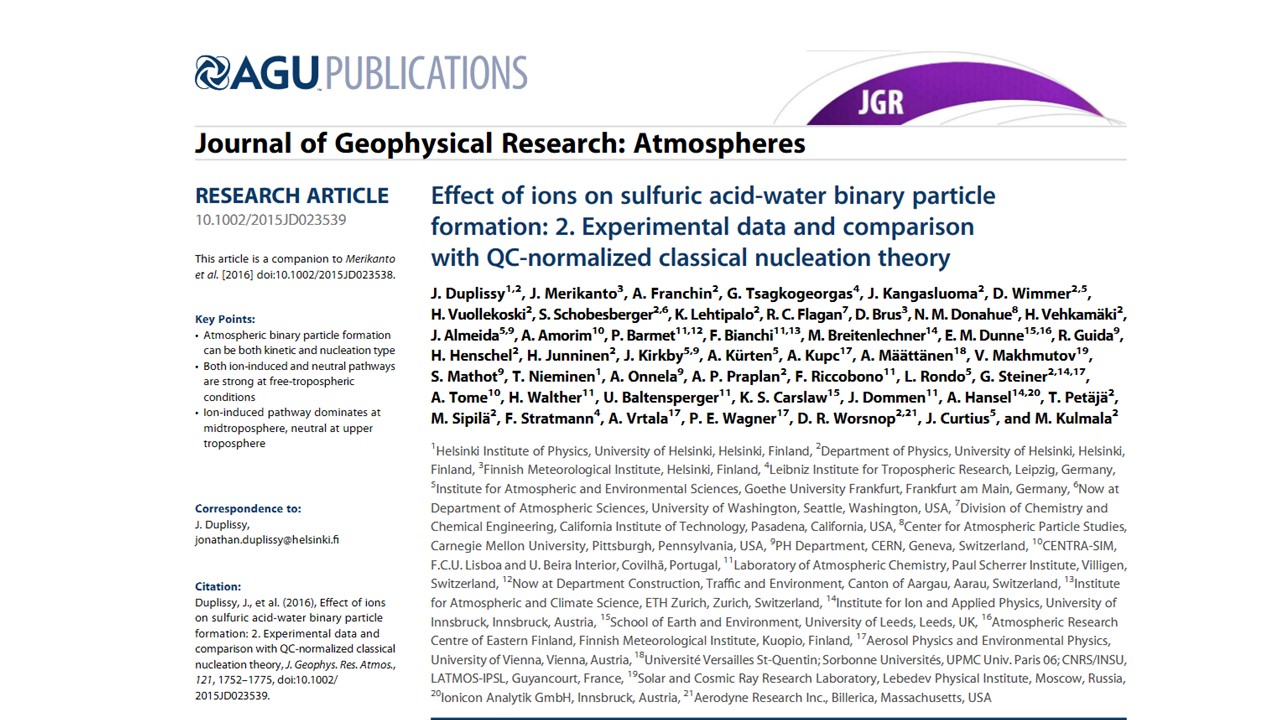
Merikanto et al. (2016) and Duplissy et al. (2016) are two companion papers recently published in JGR atmosphere. The papers investigate new particle formation in neutral and ion-induced binary sulfuric acid-water systems, a long thought mechanism of particle formation. The companion papers tackle particle formation system from a theoretical and experimental approach, respectively.
In Merikanto et al. (2016), the authors have derived a new version of Classical Nucleation Theory (CNT) in which they use a quantum chemistry-normalized form of CNT and extend the theoretical treatment into the kinetic regime where particle formation is no longer impeded by a free energy barrier. The model is validated against the measurements presented in Duplissy et al. (2016), obtained from the CLOUD experiment at CERN. In these experiments, four parameters have been varied to cover neutral and ion-induced binary particle formation processes throughout the atmosphere: Sulfuric acid concentration (1e5 to 1e8 molecules per cm-3), relative humidity (10%-80%), temperature (208-293K) and ion concentration (0-4000 ions per cm-3).
The key instrument of this study is the use of the APi-TOF-MS, which can differentiate clusters produced by pure binary processes, i.e. containing only sulfuric acid and water, from clusters also containing other molecular species. Previous studies on binary particle formation were executed with care and purported to address binary nucleation; however, most were, to some extent, burdened with ppt level contamination by base impurities like ammonia and amines arising from various sources of the experimental setup. These impurities were shown to be able to enhance dramatically the particle formation rates. This would explained why these “thought to be” binary experiments have reported so high particle formation rates. In this present study, even though not all trace gas contaminations could be detected directly in the gas phase, the APi-TOF-MS is sufficiently sensitive to determine if additional species are participating in the initial cluster formation (albeit with the limitation that it can only measure charged molecular clusters). The quality data measurements from the APi-TOF-MS make it possible for the first time to report a particle formation rate database labelled “contaminant free” or “true binary” for a wild range of atmospheric conditions.
Why are these papers important?
They provide a) the most up to date version of classical nucleation theory using quantum calculation, b) an extensive data base of true binary nucleation, and c) a thorough description of the CLOUD chamber. The authors show for the first time a very good agreement between predicted and measured particle formation rate (for hopefully the good reason). This would end the persistent mismatch between the theory and experimental data, which had been causing plenty scratching of the head from a generation of theorist and experimentalist. As the theory agrees with the data for the wild range of conditions studied, it can therefore be used to generate a big theoretical dataset that can be parameterized. This parameterization can then be used widely in global modeling and improve our comprehension of particle formation around the globe.
And outside of the office, what is the implication for the atmosphere?
The authors’ results show for example that the binary water-sulfuric acid system can produce strong new particle formation in the free troposphere both through barrier crossing (nucleation) and through kinetic pathways. In the kinetic regime particle formation rates become proportional to sulfuric acid concentration to the second power in the neutral system, or to the first power in the ion-induced system. At cold stratospheric and upper free tropospheric temperatures neutral formation dominates the binary particle formation rates. At mid-tropospheric temperatures the ion-induced pathway becomes the dominant mechanism. However, even the ion-induced binary mechanism does not produce significant particle formation in warm boundary layer conditions, as it requires temperatures below or around 0∘C to take place at atmospheric conditions.
Furthermore, the authors show that binary formation rates are very sensitive to relative humidity. The ion-induced rates at 279K and sulfuric acid concentration of 2x107 molecules per cc, for example, can be effectively zero at 30% relative humidity, but take place at close to ion pair production rate at 90% relative humidity (Fig 2).
What’s next?
Well, so far binary nucleation has not been observed in the real atmosphere, mainly because measurements were done at ground level where it is not expected to be observed (because of the contaminants). So next would be to measure new particle formation in the free troposphere and stratosphere with an APi-TOF on board.
Recent comments